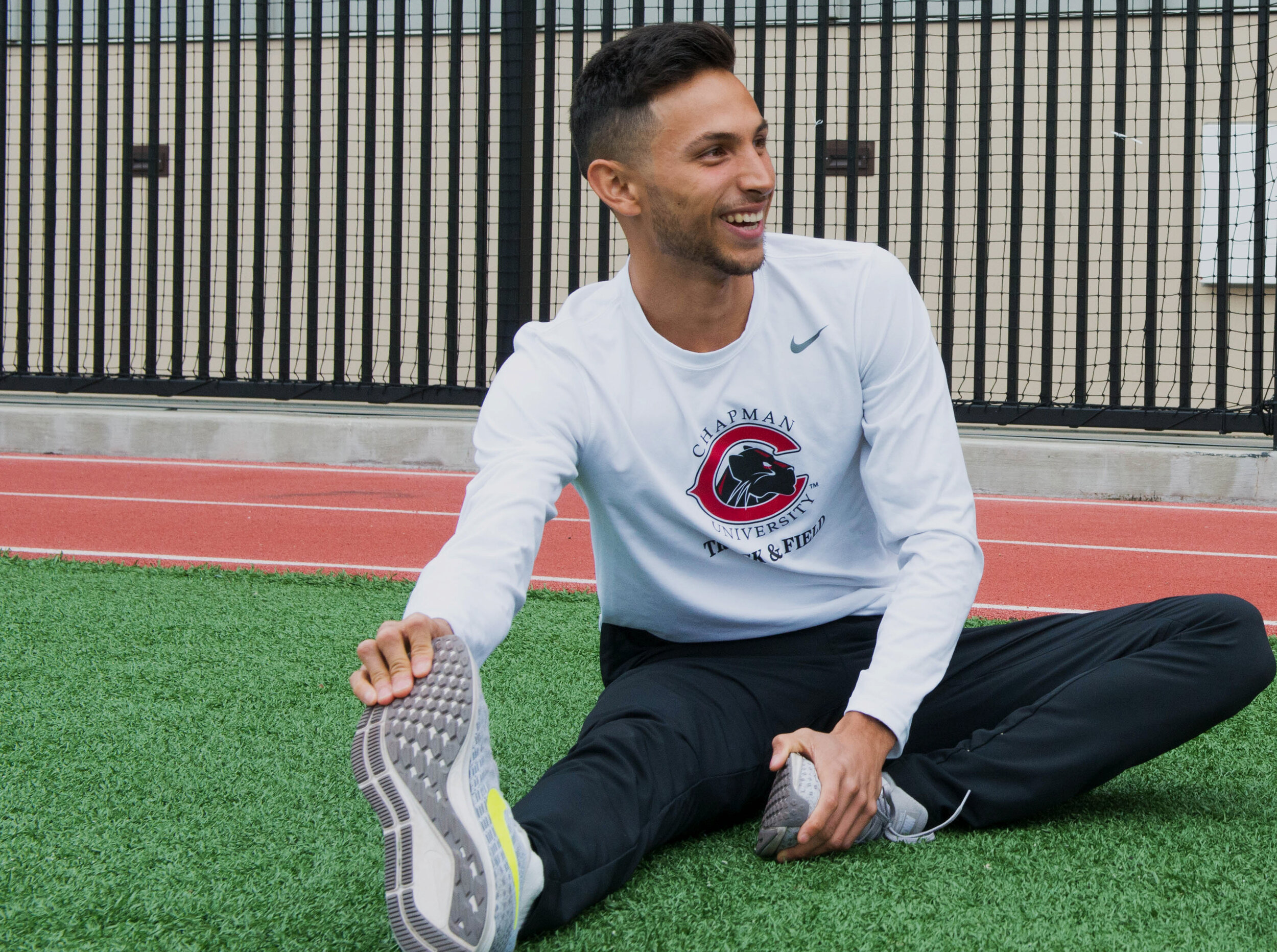‘I just race’: Sophomore sprinter looks to make comeback
Sophomore sprinter Aki Shigeyama injured his hamstring during the spring 2018 track season, but after fully recovering Shigeyama looks to break his previous season record in the 400-meter race. Photo by Max Weirauch
If you stand close enough to Aki Shigeyama on the track in the minutes before the starting pistol goes off, you might hear the faint strains of Earth, Wind and Fire’s “September.”
Before most races – especially the 400-meter sprint – Shigeyama feels a little on edge. His legs go weak. His palms get sweaty. But a range of tunes, from what he describes as “old school music” to Cardi B’s latest hits, tend to quell his nerves. And then he’s off.
“Once the gun goes off, all that stuff goes away,” Shigeyama said. “I just race.”
For Shigeyama, a sophomore business administration major, the days surrounding a meet are a routine. Ice bath. A light breakfast, usually oatmeal and fruit. Stretching and cooling down. And the same order each Saturday from Jersey Mike’s sandwich shop before him and his teammates board the bus to a meet: an Italian sub with a Glacier Freeze Gatorade (watered down, of course).
But the routine around track meets hasn’t been part of Shigeyama’s life for long. He’s a relative newcomer.
He focused on volleyball and basketball at his high school in Osaka, Japan, where he often stayed up late with his friends at a local park. When he decided to come to Chapman, he knew he wanted to play some kind of sport, but one thing was standing in his way: Chapman doesn’t have a men’s volleyball team, and Shigeyama didn’t want to continue basketball in college.
He emailed the track and field team’s then-coach Anna Wlodarczyk before he started attending Chapman, asking her for a chance to be on the roster.
“We don’t take people who don’t have track experience,” she told him.
But Shigeyama persisted. He’d considered not playing a sport in college, but the novelty of the track team had drawn him in. He told Wlodarczyk about the sports he’d played competitively in high school. That he was dedicated. Could she give him a shot?
Wlodarczyk had left by the time Shigeyama came to Chapman, but someone else did give Shigeyama a shot – the new coach, DeAndra’e Woods.
Woods, who was previously an assistant coach at Concordia University Irvine, is short, muscular and intense. When speaking, he’ll occasionally stop to, well, coach, this time calling out to an athlete who was doggedly attempting a javelin throw.
Woods remembers the transition to becoming Chapman’s new head coach; how he had to balance his time between calling athletes at his old school and telling them he was leaving – and introducing himself to new ones at Chapman.
“You know who’s serious and who’s not, who responds to emails or who gets back to you,” Woods said. “Some kids answer their phones; some kids don’t answer.”
Despite being 17 hours ahead in a different time zone, Shigeyama answered diligently. Woods, looking for someone with the discipline and the motivation to excel, saw both in Shigeyama.
“If you don’t have the discipline to do something, then the motivation subsides, sits off on the wayside,” Woods said.
Shigeyama established himself as a reliable member of the team. His 2018 season best of 23.49 seconds in the 200-meter is about three seconds slower than runners who went on to place in the conference championships. However, he was the team’s fastest in the 400-meter that year, at 52.34 seconds. He was steadily improving.
Then, in one moment on the University of LaVerne’s track in March 2018, Shigeyama’s barely six-month-old career as a track runner came to a halt. There was searing pain. And in that moment, he knew he was done for the season.
The then-freshman had just injured his hamstring. Again. With the conference championships just about a month away, Shigeyama had begun to feel tired during practice. Fatigued, even. His recovery time wasn’t as fast and often, and the volume of training felt overwhelming.
He’d made it this far – Shigeyama already recovered from a hamstring tweak a few months earlier in his freshman season. But this time, he knew he was overworked and he knew his season was over. And it was only late March.
“The way I injured it in that moment, I knew I was out,” Shigeyama said.
Woods remembers the moment he saw Shigeyama fall that day. He knew Shigeyama had tweaked his hamstring a few months before. This time, it was more serious.
“It’s always difficult. You don’t want to see any of your athletes injured,” Woods said.
After nearly a full season of adjusting to the sport and its workload, Shigeyama was already on hiatus, and the injury – never officially diagnosed, but thought to be a spasm or a tear – didn’t just affect his athletic life. Often, he struggled to bend to pick something up if he’d dropped it. He had to be careful about how he moved his leg. That didn’t deter Shigeyama, though – it drove him to come back, stronger.
“Of course I was discouraged, but I never once thought of quitting track,” he said.
Now, nearly a year later, a fully recovered Shigeyama wants to make it to the conference championships. He’s also aiming to break less than 50 seconds for his 400-meter race, undercutting his previous best time of 52.34.
“In track, two seconds is a lot,” he said.
Woods can often tell what an athlete will excel at within a few moments of watching them run. For Shigeyama, he knew the 200- and 400-meters were his best bet. But, as much as a coach can, Woods steps aside when it comes to athletes’ season goals.
“Whatever he wants, I want for him,” Woods said. “It’s his athletic experience. I already had mine.”

